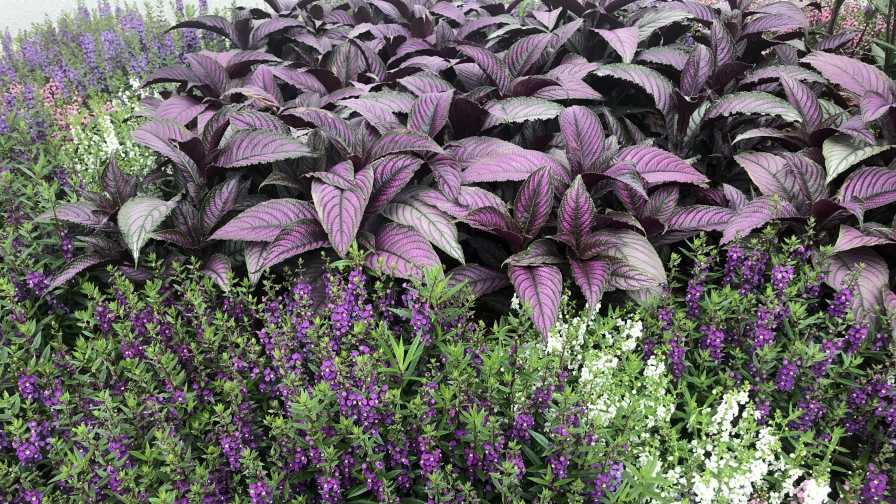Maybe Friends Should Let Friends Buy Annuals

These strobilanthes and angelonia are displayed in a mixed bed at the entrance to a shopping mall in Athens, GA. Landscapers often look for annuals that will flower continuously on their own.
Photo by Allan Armitage
I first read the expression “Friends don’t let friends buy annuals” on a Plants Delight Perennial catalog many years ago. Now, I see it on bumper stickers handed out by woody plant nurseries and non-annual growers. I still think it is as cute as it was when I first saw it, and I still enjoy saying it out loud, but only to those who know it is a tongue-in-cheek expression. It has become part of horticulture folklore.
Annuals Have Always Been the Brunt of Plant Snobs
“Oh no, not another red geranium,” or “Marigolds, ugh!” Lovers of annuals quickly realized that such expressions were a back-handed way of complimenting the astonishing amount of breeding in the last 30 years. Today, it appears that breeders of other crops have caught up, because now I hear “Oh no, not another heuchera, or “If I see one more hydrangea, I may be sick” (that last one is mine).
Annuals Are a Starter House for Gardeners
Homeowners are more comfortable with annuals than they are with perennials and shrubs. The beginner will timidly start off with a pot or two of begonias for shade, some petunias for sun, and a few calibrachoas for containers. Then, with a little success, they want to build a bigger house. They graduate from annuals to perennials, then to shrubs and trees. But as any garden center worker will attest to, annuals never go away, and color is a necessity, even for the veteran gardener.
Annuals Are a Mainstay for Landscapers
Landscape architects always leave a space for color on their drawings, even though they don’t know which plants to choose. Commercial properties are often dominated with strong palettes of pigment because color is what people notice and remember. There are no more effective 55-mile-an-hour plants than annuals.
As a lifetime fan of annuals, I try to keep up with what my neighbors and local landscapers are doing with annuals, and what trends I am seeing and how they develop into what breeders are offering.
A Few More Thoughts Pertaining to Annuals
Color, color, color: As always, regardless of landscaper or gardener, the number one reason for the selection of annuals is for continued color. That is why the most popular sellers are those that either flower continuously on their own or respond to cutting back by producing more flowers. No other group of plants can provide the sustained color palette of annuals. That is their strength.
Rivers of color or splotches of color: While large swaths of color are always welcome in commercial landscapes, containers have become the mainstay for annuals at home. To select plants and maintain containers on the deck or veranda is something almost anyone can get their minds around. Baskets are similarly useful for annuals, but they require more maintenance and seem to have fallen out of favor.
Which Brings Me to the Downside — Maintenance
For large beds of color in commercial landscapes, the planting, feeding, weeding, deadheading, watering, disease and insect control, and fall clean-up are simply part of the contract. However, a poorly designed and poorly maintained annual planting is a depressing sight indeed. On the other side, home gardeners also love the Picasso-like color of an annual bed, but the idea of selecting for proper performance and maintaining them is too time-consuming.
Even for residential landscapers, the time and cost of planting and maintaining beds of annuals is a difficult proposal in these days of labor shortages. Not only that, most landscapers do not have sufficient expertise to choose the proper annual genus (let alone cultivar) to reduce maintenance based on proper selection. The perception of higher maintenance for annuals has opened the door to enhanced sales of shrubs and perennials.
That is not to say that annuals are going anywhere. They are always what draws the eyes of consumers at the retail shop and what welcomes people to restaurants, hotels, and shopping malls.
Breeders Continue to Work Their Magic on Annuals
Nearly all annuals are available from seed, even those like calibrachoa that started out as cuttings only. Regardless of propagation method, reduced time on the bench, cooler temperatures, and extraordinary germination and rooting are all the result of breakthroughs in breeding.
We now see the beginning of downy mildew resistance in impatiens. In 2019, two series of mildew-resistant impatiens were introduced. I expect to see more choices in the very near future. Zinnias used to be the host for dozens of diseases, and now choices are available that are remarkably disease free. Begonias have essentially been reinvented — so many choices of wax begonias are available — but also balanced by so many extraordinary basket and container selections.
I can’t think of any mainstream annual that is not available in a short and compact form. Some designers may wish for old-fashioned tall and rangy plants, but most gardeners and landscapers welcome the reduced maintenance. Many genera of annuals have been bred not only for compactness and breaks, but also for pendulous habit, especially useful for containers and baskets.
Annuals benefit by being thought of as old-fashioned (e.g., grandma’s geraniums and mother’s rex begonias), but breeders have taken the old-fashioned geraniums and begonias and made them haute-couture. This is the best of all worlds.
I could wax eloquent for days about annuals, but the most important thing about any of our plants — annuals, perennials, ferns, bulbs, shrubs, and trees is that they complement each other, and as growers and users, we really do have the best of all worlds.









